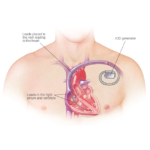- A small incision, approximately two to four inches long, will be made in your upper chest area, just below your collarbone.
- One or two leads will be guided through a vein into your heart, and the leads will be connected to the defibrillator.
- The defibrillator settings will be programmed, and the device will be tested to ensure it is working properly to meet your medical needs.
- The defibrillator will be inserted beneath your skin, and the incision in your chest will be closed.
AFTER SURGERY
You will usually stay in the hospital overnight and go home the next day with instructions on caring for your incision. Your doctor will provide more detailed information, but most individuals can expect to gradually return to their everyday activities shortly after the procedure.
After an ICD system implant, your doctor may want to limit how much you move the arm that is closest to your implant site, for a short time after implant. There may be a slight bulge visible under the skin where the device is located. The leads are very thin and will not be visible.
Each individual’s experience may be different. Talk to your doctor for specific information regarding the implant of an ICD.
REPLACING YOUR ICD
Implantable heart devices are designed to provide therapy for years, but eventually you may need to have your device replaced.
During an ICD replacement procedure, or generator change, your doctor will make a new incision over the old one and then remove the old ICD. He or she will then disconnect and check the leads to determine if replacement of the leads is also necessary; they may or may not be removed.
The leads are connected to the new ICD and its function is tested. The new ICD is then inserted, and the incision is closed. Finally, the device’s therapies are programmed.
When you get your ICD replacement, you may actually receive a newer model with new features and technologies.
When it’s time to replace your ICD, or if your heart condition changes, talk to your doctor about different devices and their features. Only your doctor can determine what’s right for you.
Implantable Cardiac Defibrillators (ICD’s) are implantable devices similar to cardiac pacemakers, however these devices are implanted in patients who have life threatening arrhythmias, such as Ventricular fibrillation or are at risk for sudden cardiac death.

